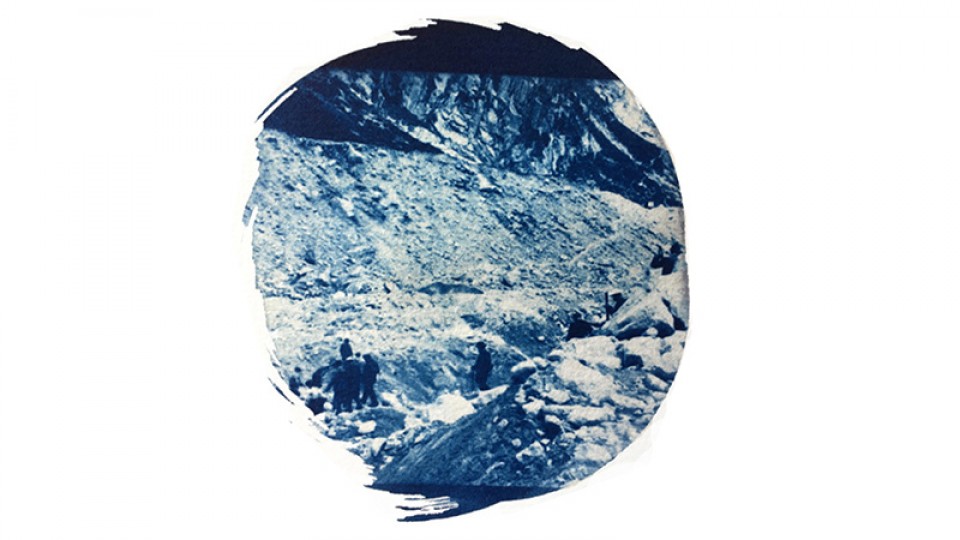
Opening
Thursday 19 August 11am-8p
Opening hours
Tues-Sat 11-5pm; Late Night Art until 9pm.
COMPLETELY SILENT AND TERRIBLY, TERRIBLY OLD
Selma Makela, Nollaig Molloy, Euan Gébler, Susan Hughes; curated by Susan Hughes
Ends 04 September 2021
This project is part of the Emerging Curators Programme. This series aims to support emerging curatorial practice. The curator will realise a project with artists/ and subjects of their choice.
“Away from the roar of the sea
the island was quieter than the valley at home, completely silent and terribly,
terribly old.” (Tove Jansson, 1948)
The artists in this exhibition, Selma Makela, Nollaig Molloy, Euan Gébler and Susan Hughes, have a curiosity about the materials under their feet and in their hands.
Seduced by particular spaces,
they navigate their way quietly, unsure if they are grounded beings in an alien
environment, or if they themselves are the aliens. If you came upon any one of
these artists at work you might see them prod something spongy with a fingertip,
turn a rock with a foot or stop stock still to listen to the air. You would
equally find them rapt in conversation with a human they may have encountered;
this act of gathering stories is a form of research they each value highly.
In this show you will find
minerals and environments metamorphosed, utilised, exploited and worshipped.
This exhibition will incorporate music performances by some of the
artists in the stairwell and on the roof terrace of PS² during the
opening evening and at various points during the run of the exhibition.
Keep an eye on our social media for updates.
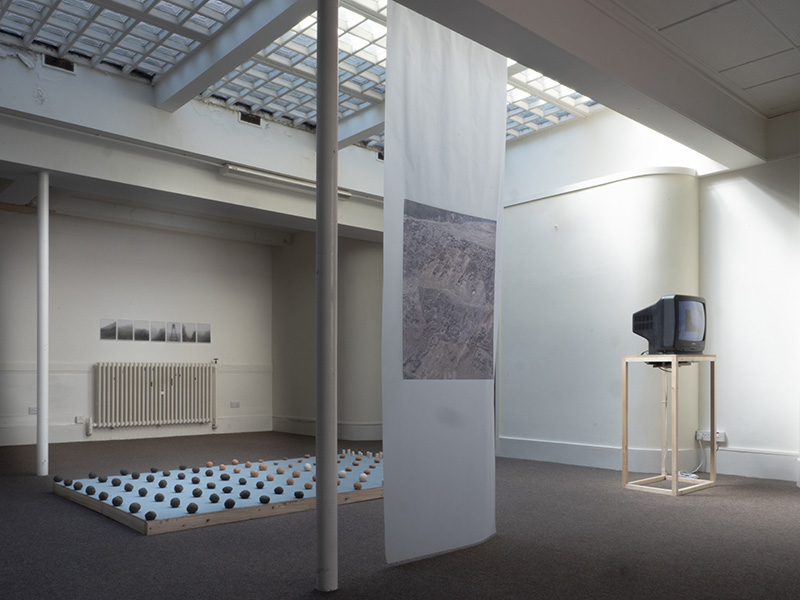
Installation view. Image Euan Gébler
REVIEW- by Slavka Sverakova
'Under the somewhat scary title (taken from a text by Tove Jansson, 1948)
COMPLETELY SILENT AND TERRIBLY, TERRIBLY OLD, four artists, Selma
Makela, Nollaig Molloy, Euan Gebler and Susan Hughes exhibited
installation, sculpture, cyanotypes, audio tape, hazel branch, and
video. The sensitive installation is due to one of the artists, Susan
Hughes. Her debut is rather an excellent application of sense for
measure and rhythm of volumes and angles and sizes with a niche favour
for privacy and individuality of what is visible. As it is a part of
Emerging Curators Programme, I cherish her success.'
To read the full review, see Slavka Sverakova blogspot
Artist, writer and activist Niamh Scullion has observed the installation of the project and wrote a text about the work of each artist, with careful observations and detailed descriptions. To read the full text, klick here.
Selma Makela’s work engages with
themes relating to the climate crisis. Making work derived from lost and found
ephemera she explores ideas relating to distance and dislocation, both in terms
of geological timelines and our position within them.
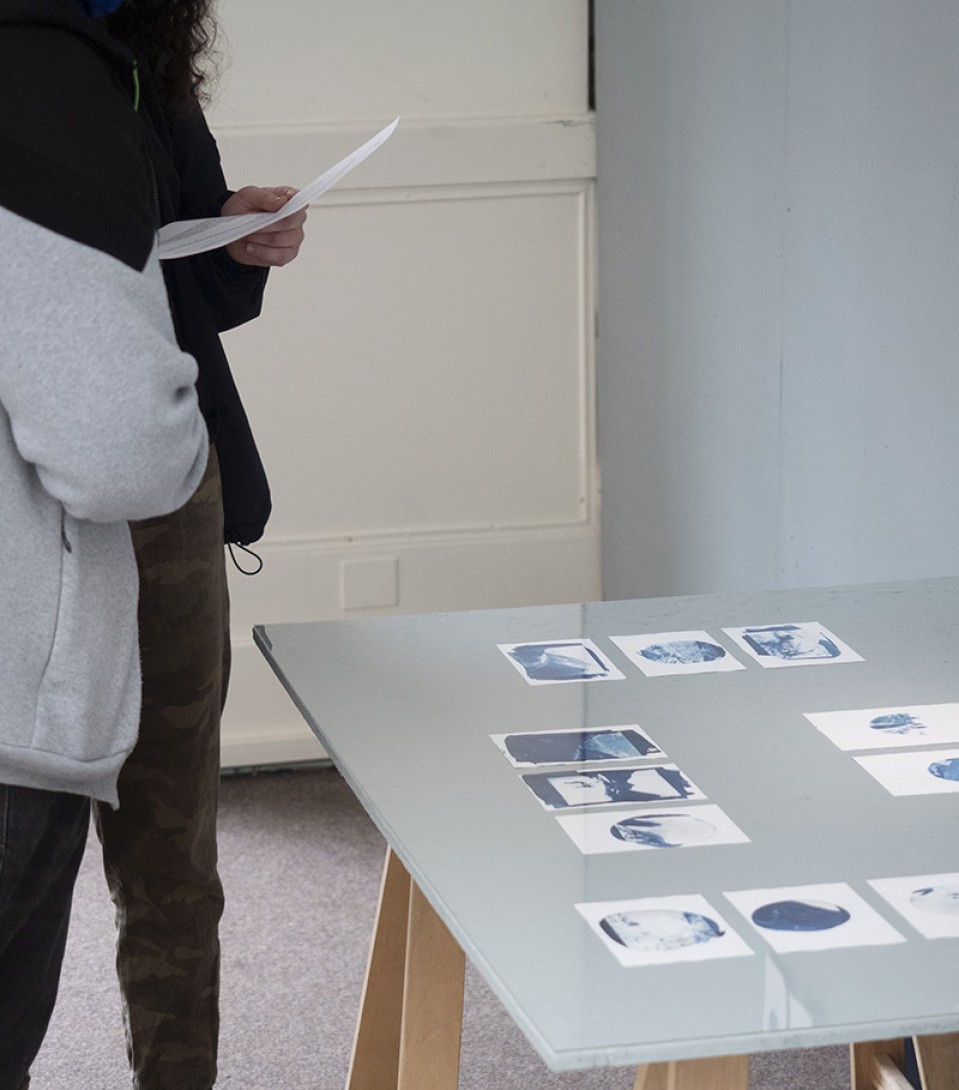
Selma Makela: installation view. Image: Euan Gébler
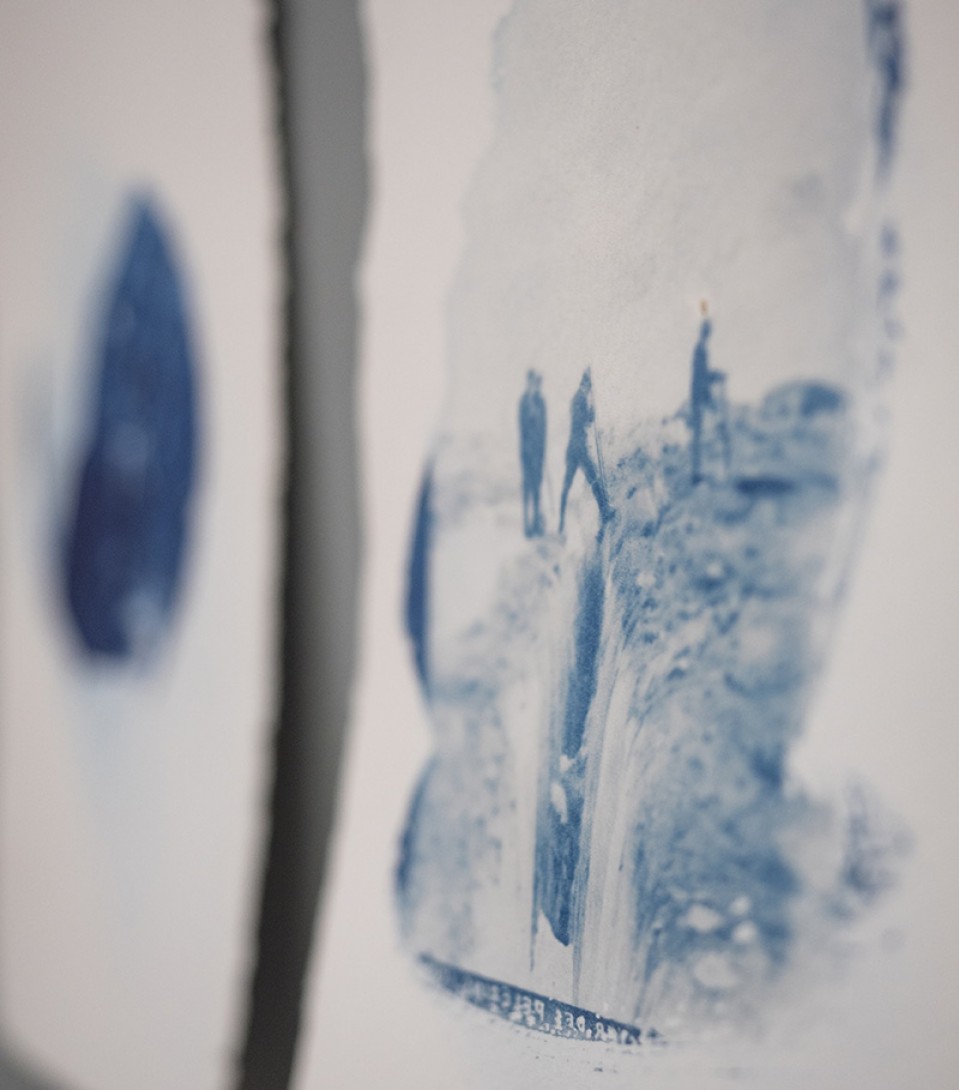
Selma Makela: Future Haunting. Image: Euan Gébler
Future Haunting is a series of
Cyanotypes developed from an archive of 19th century glass negatives containing
images of glaciers from the French alps. This work explored contemporary
archaeological practice, looking beyond linear constructs of time, and
objective perceptions of matter, to reflect on contemporary ideas of human and
non human entanglement and haunting.
Temporal images of another time alchemically appeared from the slides with sunlight, water and iron. The process was a ‘haunting’, not only because of the imagery it represented of lost glaciers and people, but also the vast time spans of the materials involved.
The circular compositions hint at celestial bodies, referencing proposed future mining. Rather than view the images solely as a past of lost glaciers, the haunting encompasses us all as ghosts entangled with the future in the time of The Anthropocene.
Selma Makela is based in Galway.
She has been the recipient of awards from Arts Council, The Model (Sligo),
Leitrim Sculpture Centre and Galway County Council.
She has completed many
artist residencies including Fogo Island Arts, Newfoundland (2011) and
Fleck Fellowship & Residency from Banff Centre, Canada (2010).
From Niamh Scullion's text
'....Two cyanotype prints are side by side on the wall, several are arranged under glass on a table, lit up by a little spotlight. Mountain snow scenes in blue and white, images from the early days of camera. Some of the prints are rectangular but most are in rough swirled circles, like a moon, like a spyglass or a peephole. There are human forms on the side of steep white mountains, figures in full formal Victorian dress, women and men on a journey captured at different altitudes or crossing a wide ice crevasse dropping who knows how deep. The figures turn back to look at the photographer and though we can’t see their faces we know they aren’t smiling. This is a solemn journey into the unknown. They know that someday in the future people will see these photos and wonder. We don’t know whether they are on an adventure or a quest, or if it’s a journey they have no choice but to take? We don’t know. We can’t ask them. We can only watch and wonder, study the photos and hope that they will give up some secrets. The title of the exhibition: ‘Completely silent and terribly, terribly old’ comes from a Tove Jannson Moomin book. I think of another line from that book, that ‘adventure is just like a holiday but real change is hard’.
EUAN GÉBLER
The world speaks if we know how
to listen. The earth, the stone, the places we build and the places we destroy.
They all tell their stories; in quiet murmurs and deafening roars.
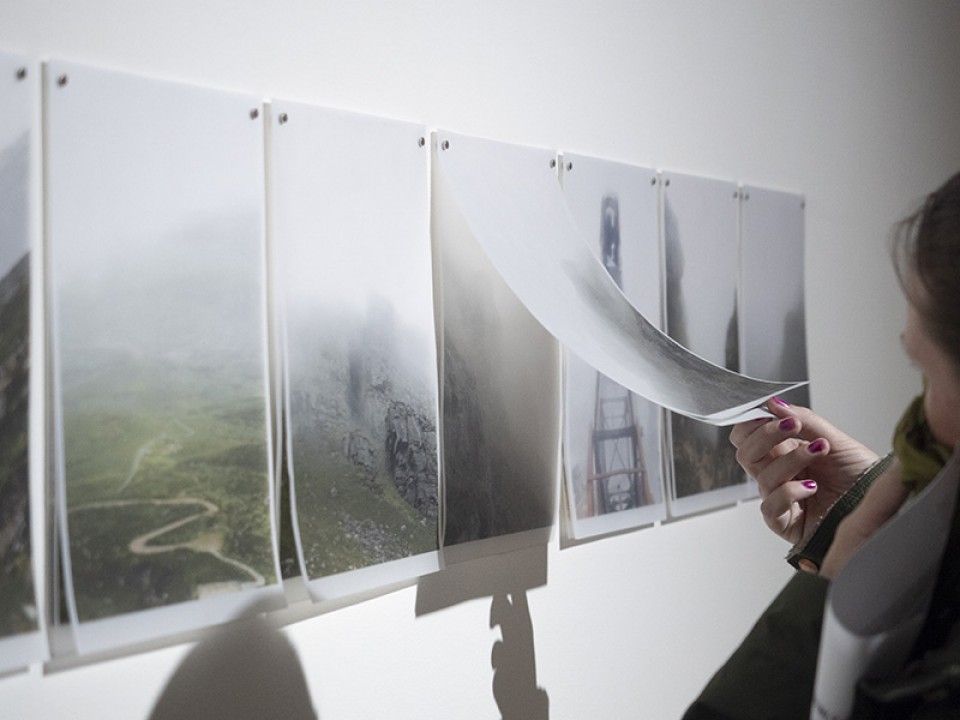
Euan Gébler: 'Seeing through Stone', Photographs on tracing paper. Image: Euan Gébler
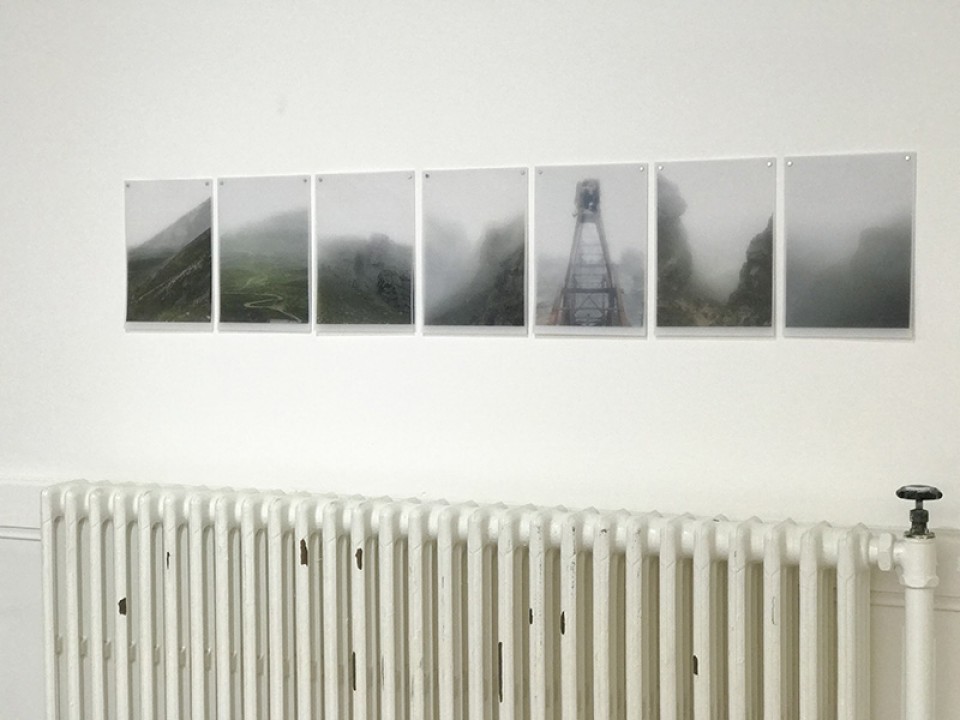
Euan Gébler: 'Seeing through Stone', Photographs on tracing paper. Image: Euan Gébler
Photography, video, and sculpture are the tools in a process of constant investigation into the many worlds -overlapping and contradictory- that we inhabit. From searching for spirituality in the waiting rooms of psychics’ offices to spying on the very data centres that spy on us, chasing human connection on ChatRoulette or finding stillness in the calamity of industrial quarries; an often playful engagement with site is at the core of my practice. The stories, materials, and aesthetic language of these unusual sites of contemporary culture become tools to make sense of the forces that structure our lives. I’m interested in the connections between the environments we construct: private psychological ones, shared cultural ones, and the real physical and virtual spaces we inhabit.
Euan Gébler is an artist based in Belfast. He graduated from the Belfast School of Art with a BA in Fine Art in 2021. He received the Cultúrlann McAdam O’Fiaich Student Graduate Award and was longlisted for the 2021 RDS awards.
euangebler[at]gmail.com
From Niamh Scullion's text
'Euan Gebler shows a series of layered, misty photos of a winding trail up to a quarry cut into the back of Muckish Mountain. They are printed on translucent paper, a bit like mist itself. The photo at the rear is like a vague impression, obscured through the mist of the first two. The effect is haunting, hard to put your finger on. It is as if it is a motion photo and the focus is moving from the photo at the rear to the photo at the front, or that the mist is moving through layers towards us. It feels a little bit illicit to lift the images, to look underneath, to see the inner workings and feel them sensually. I always love an exhibition that includes tactile elements. An old rusted crane rises out of the mist in one of the photos, with layers of the same crane from different positions emerging through the paper from behind, like an aura of that crane or the ghost of it. The first layer shows the crane rising clear out of the mist, the next layer focuses on the crane behind the mist, the next one on the mist surrounding the crane. Seeing all these levels of focus and all these vantage points at once is overwhelming and ethereal.
Another work, hanging from ceiling to floor, shows an image of Sean Quinn’s quarry in Tyrone near the border. It’s the quarry belonging to the man who made his fortune by demolishing a mountain, then he demolished his relationships and reputation afterwards. The quarry image is a disturbing vastness of the manmade mountainous destruction, where the rocks look more like concrete than natural rocks, where they look industrial and inhumane. There is something strange and dizzying about the photo and I initially can’t figure out what it is. Closer up, I am dizzier still until I discover a faultline in the photo, a perfect circle where things are not as they should be. The circle has been cookie-cut into the photo and flipped over so everything is inside out and upside down. It’s a puzzle I wish I had been patient enough to unravel myself. The element of revelation adds a triumphal spark to the brutal grandeur of the quarry, suspended in translucence.'
Nollaig Molloy is a visual artist who explores materials from landscapes and sites looking at their relevance to historical, social and industrial situations. Her past projects include working with Belfast's HIVE Choir (2021) creating a series of live radio broadcasts from a lake boat on the River Shannon (2018) and exploring rock salt from 1500 metres underground in a working salt mine (2020).
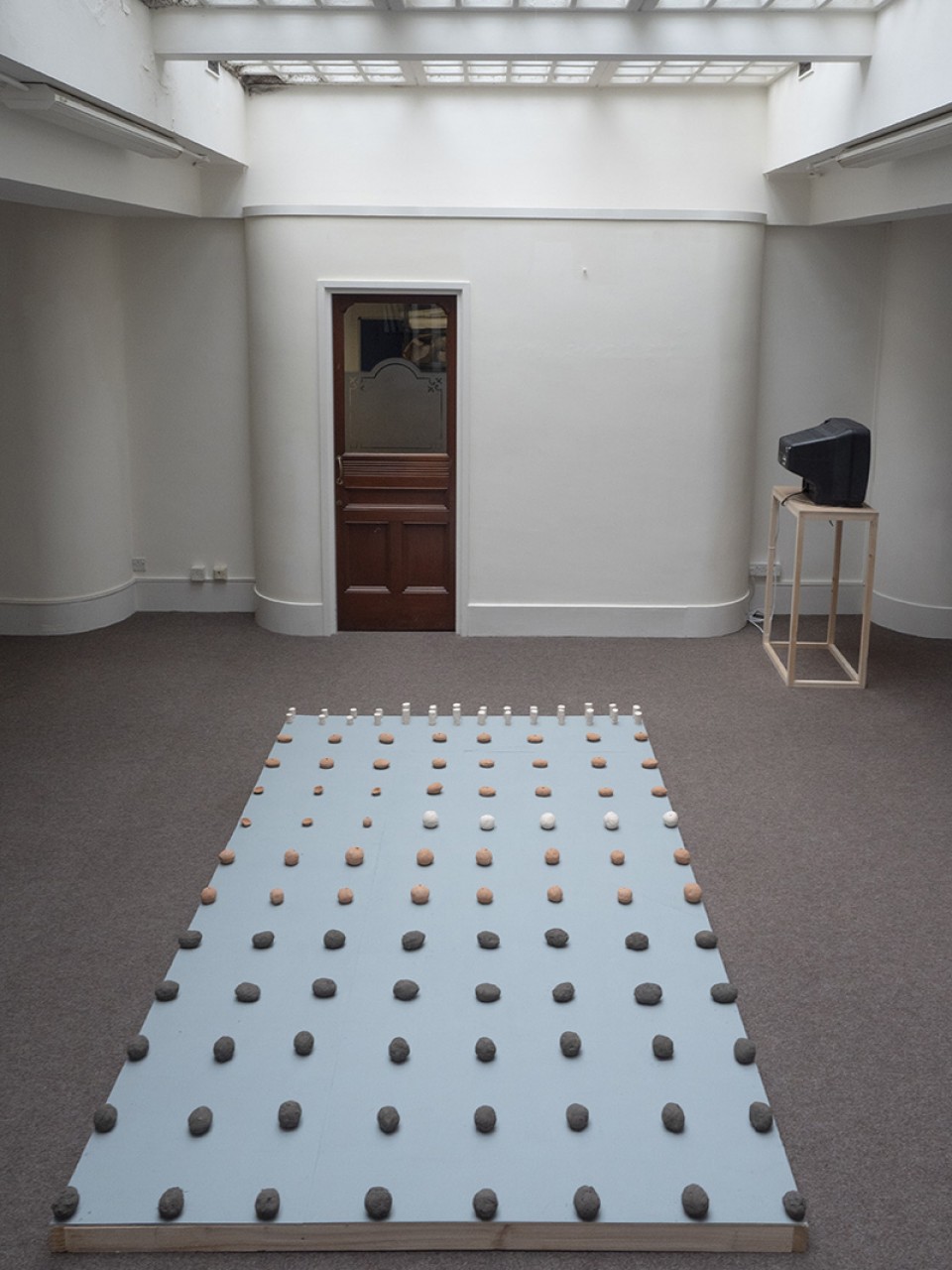
Nollaig Molloy: installation view. Image: Euan Gébler

Nollaig Molloy: Grenades, Pellets and Balls Coal slack, fired and unfired coal dust, local daub clay. Image: Euan Gébler
In this exhibition she presents
work made during a residency in Leitrim Sculpture Centre (2017) where she
collected and experimented with local clay from various sites around the
locality. The rick of unfired and fired culm balls, grenades and
pellets consist of various recipes of coal slack or coal dust applied to a daub
clay mixture. They are formed by dexterous movements, repetitive and confident
in manipulation. Nollaig is interested in the idea of ‘material-to-hand’,
casting connections between place, landscape, language, value of labour and
handcrafted objects.
Nollaig, now based in Sligo, graduated from Belfast College of Art in 2020 with a Masters of Fine Art. She is currently undertaking a development residency with Belfast Print Workshop and is taking part in Grass Roots; the first year of Muine Bheag Arts, Muine Bheag Co. Carlow.
From Niamh Scullion's text
'The strongest light in the room, nearly quite at the centre, is filtering through the glass bricks in the exhibition space and it illuminates a large grid made up of balls of earth, clay, and charcoal created by Nollaig Molloy. There’s an Irish word for such a grid: a rick. So this grid and this word are embedded in the Irish psyche. The balls of clay are imperfect and asymmetrical, rough earthiness arranged together mathematically. The balls at one end are pure earth and charcoal, black and rough and natural, the next rows are brown: younger and more natural earth, then there’s a layer of grenades of fired red clay, with a hole in each, the hole is necessary for firing and it seems to mark the grenades as less natural, more man made than the balls of charcoal. Then comes the white clay ovals and bowls, and other recognisably human forms, and finally little stands of cylindrical clay, hollow, like bones stand close together at the end.
...I read over the Irish words and their curious tiny and earthy meanings, as the artist voice reads the English meanings in her audio piece: Traitin: a strong blade of grass, Cialog- the last sod ploughed in a field. I’ve come to love the inventiveness and excess of Irish language in the last couple of years, since reading Manchan Magan’s 32 words for field and following his Gaeltacht Tamagotchi series. I was taught Irish at school, I had Irish classes after school, I went to the Gaeltacht one summer, but none of this teaching ever struck me as any different from any other language. But Irish is different, very different. The attention to detail is astounding to the point of being comical. Why create a new word to denote a particular type of blade of grass. Is it an unnecessary detail? Is any detail ever unnecessary? Aren’t unnecessary things the most fun?
Is traitin a word that was made up just for the fun of it, for the joy of making up new words? It makes me think of Douglas Adam’s book, the Meaning of Liff, a dictionary of things there aren’t any words for yet. It was written to provoke laughter, but it made me think too of the origins of language. What happens to communication and the language centres of your brain when you have a different word for every state of being, every blade of grass. It seems to become further removed from other languages. It seems to inhabit the land and our bodies. It is tied closely, carefully, macro focus and a bit of mischievousness with the forms of nature. What in the psyche and culture of Irish people caused them to study and name each particular type of blade of grass? Do we still have that tendency or has it been lost as the language was lost?
I start to wonder - who gets to make up new words? Can I?'
The experiences which form the
content of my work are complex and multi dimensional. I and my subjects relate
deeply personal physical and physiological sensations while being inside our
bodies, inside intense encounters with nature. Digital video is used as a story
telling tool, effective in its artifice, to explore and express these natural,
yet often psychedelic sensual experiences.
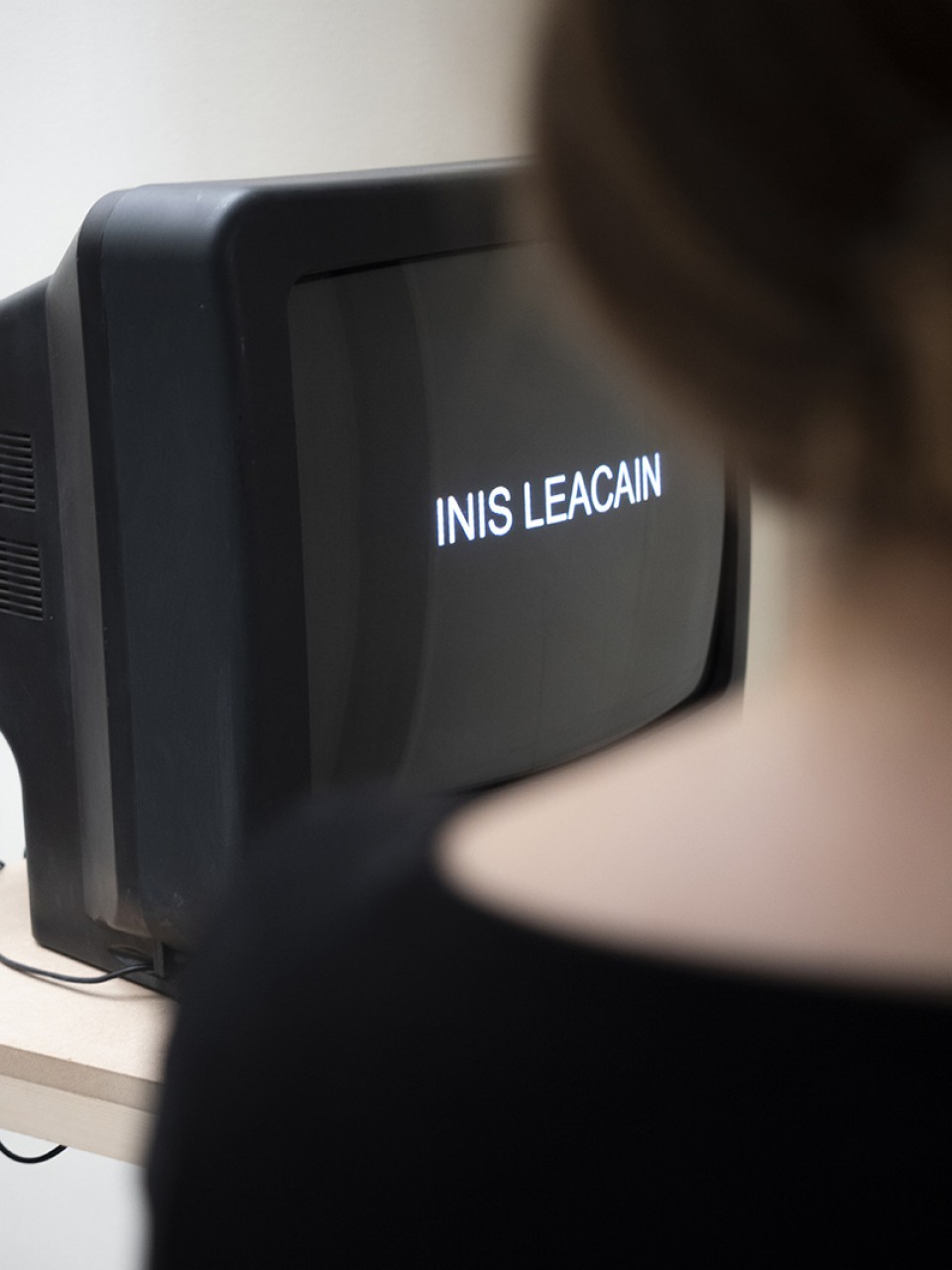
Susan Hughes: Inis Leacain, video. Image: Euan Gébler
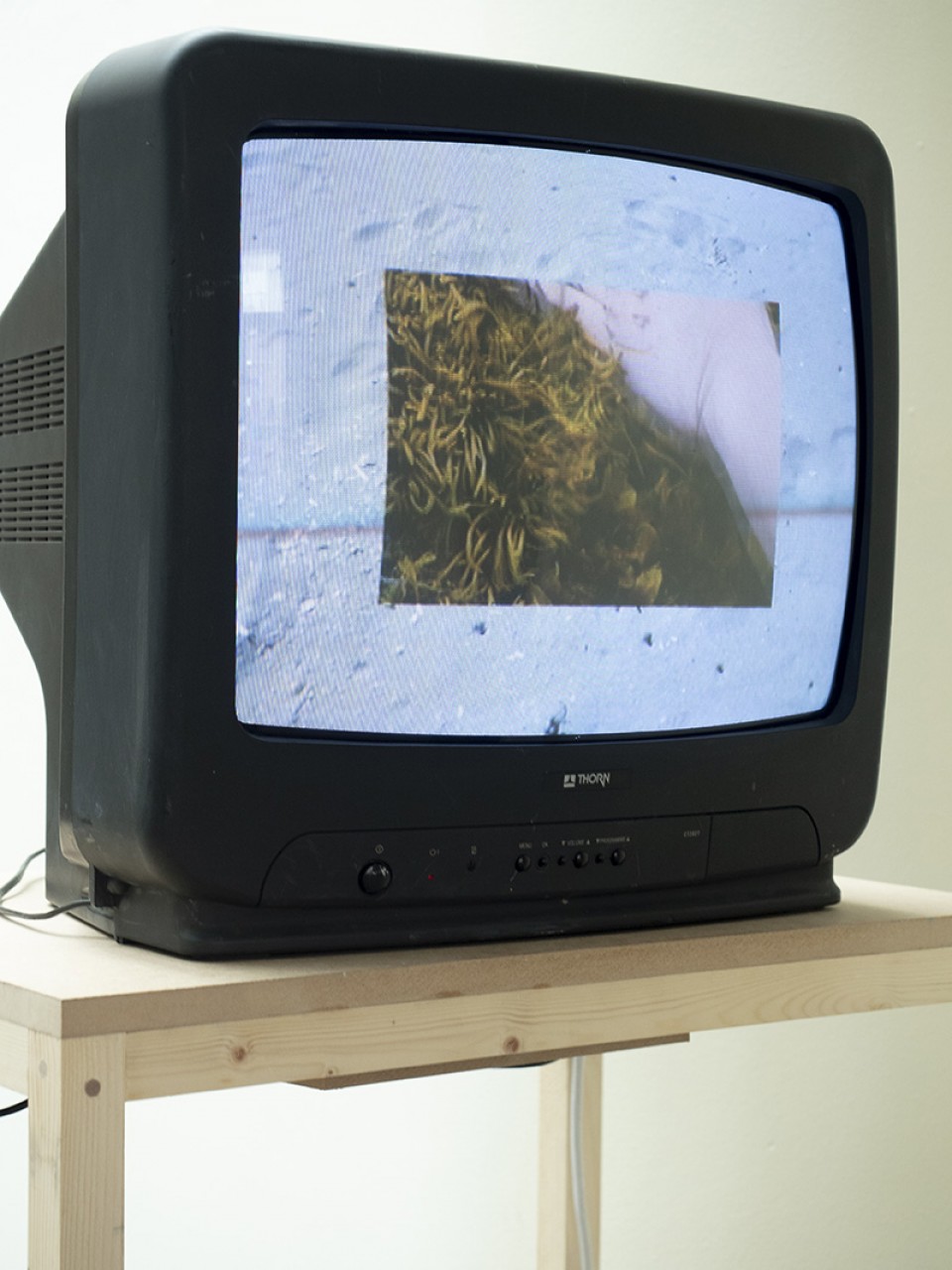
Susan Hughes: Inis Leacain, video. Image: Euan Gébler
The work presented here was made
in response to spending time on the tiny island of Inishlacken during artist
residencies in 2019 and 2021 which coincide with the Summer Solstice. The
island is uninhabited by humans which provides a foundation of privacy and freedom.
There is a visceral immediacy to elements of stone, water and air. The tide is
a relentless controlling force while the skylarks’ song does not abide. I spent
time touching surfaces, bathing in the sea and seaweed, listening and telling
stories, singing and building a stone wall.
Susan Hughes is from Belfast. She has completed many artist residencies in Ireland and Scandinavia where she has used her fiddle playing as a bartering tool to gain access to local stories. She graduated with an MFA in 2021 from the University of Ulster receiving the CCA and Platform Arts Graduate Awards.
From Niamh Scullion's text
'I move behind the quarry image to the darker, more intimate part of the exhibition space and stand before an old box TV, with the screen flickering faster than our eyes can detect. Susan Hughes’ video is halfway through, and her hand is between two wet rocks, exploring the dark crevice full of seaweed and sensual life. It’s a double frame video and in the frame behind, she kneels on the hot dry sand and runs her hand through it, leaving patterns of trailing fingers, sculpting the sand into swirls and waves and ripples, feeling every grain as it passes over and through. The foreframe video changes and she’s got her hand deep in luscious short seaweed, she grabs it, turns her hand over and wallows in it, covered in little wet, slimy bits, while in the rear frame, more sensual enjoyment goes on obscured by the central video. It’s secret, it’s both at once, it’s overload and overlayered, you’re trying to process one sensual movement and another sensual movement is speaking to another part of you, beyond and behind focus and awareness. You’re magnetically drawn to the screen until it turns black and you leave before the loop reels you in again'
Image top: Selma Makela


